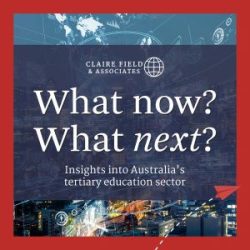The Ministerial Direction that pertains to Point 3.3 of the Migration review: Apply greater and more targeted scrutiny to student visa applications from high-risk providers has been released.
Signed on the 14th of December by the Minister for Home Affairs the Direction is entitled “This Direction is the Direction 107—Order for considering and disposing of Student Guardian visa applications and offshore Subclass 500 (Student) visa applications and may be cited as Direction 107”
Part 1 – Preliminary
1.Name of Direction
This Direction is the Direction 107—Order for considering and disposing of Student Guardian visa applications and offshore Subclass 500 (Student) visa applications and may be cited as Direction 107.
2.Commencement
This Direction commences on the day after the date of signature.
3.Revocation
Nil.
4.Application
(1) This Direction applies to delegates of the Minister who consider Student Guardian visa applications and offshore Subclass 500 (Student) visa applications under section 47 of the Act, and consider and dispose of Student Guardian visa applications and offshore Subclass 500 (Student) visa applications for the purposes of subsection 51(1) of the Act, including applications in respect of matters remitted from the Administrative Appeals Tribunal.
(2) This Direction does not apply to applications where it is readily apparent that the criteria for the grant of the visa would not be satisfied.
(3) This Direction does not apply to the Administrative Appeals Tribunal.
(4) To avoid doubt, this Direction applies to an offshore Subclass 500 (Student) visa application or a Student Guardian visa application made, but not finally determined, before the commencement of this Direction, and to an offshore Subclass 500 (Student) visa application or a Student Guardian visa application made on or after the commencement of this Direction.
5.Preamble
(1) High levels of demand for Subclass 500 (Student) visas have created a need to manage the consideration and disposal of applications for these visas in an orderly fashion.
(2) The order of priorities for considering and disposing of Student Guardian visa applications and offshore Subclass 500 (Student) visa applications that is specified in this Direction gives effect to the Government’s policy decisions as to the appropriate allocation of resources in considering and disposing of such applications, takes into account the Government’s policy intentions concerning the size and composition of Net Overseas Migration (NOM), and advances the national interest by facilitating the integrity of the program and management of Australia’s borders.
(3) This Direction directs delegates with respect to the performance offunctions and exercise of powers under section 47 ofthe Act and section 51 ofthe Act, when determining the order for considering and disposing of Student Guardian visa applications and offshore Subclass 500 (Student) visa applications.
(4) The Simplified Student Visa Framework (SSVF) is a Departmental policy which is applied to all Subclass 500 (Student) visa applications. Under the SSVF, each country and each Commonwealth Register ofInstitutions and Courses for Overseas Students (CRICOS)-registered education provider is allocated an evidence level based on immigration risk. Evidence levels are then combined to form a rating on a scale from 1 to 3, which guide financial and English evidence requirements for Subclass 500 (Student) visa applicants. There is no connection between the evidence framework and the quality of an education provider. An Evidence Level 1 (ELI) rated institution benefits from having the most streamlined evidence requirements. For the purpose of processing offshore Subclass 500 (Student) visa applications, SSVF Evidence Levels and this Direction are intended to work together, with this Direction setting out the overall priorities for the processing of offshore Subclass 500 (Student) visa applications and Student Guardian visa applications, and the SSVF specifying a risk based approach to evidence requirements for Subclass 500 (Student) visa applications.
Notes:
Subsection 51(1) of the Act empowers the Minister to consider and dispose of applications for visas in such order as he or she considers appropriate.
Subsection 499(1) of the Act empowers the Minister to give to a person or body having functions or powers under the Act written directions not inconsistent with the Act or the Regulations, in accordance with which the person or body shall perform those functions and exercise those powers. The person or body must comply with the direction.
6. Interpretation
(1)In this Direction:
Act means the Migration Act 1958.
Defacto partner has the meaning given in subsection 5(1) of the Act.
Defence student has the meaning given in regulation 1.04B of the Regulations.
Dependent child has the meaning given in regulation 1.03 of the Regulations.
ELI rated institution means an education provider that has been allocated an Evidence Level of 1 under the SSVF.
EL2 rated institution means an education provider that has been allocated an Evidence Level of 2 under the SSVF.
EL3 rated institution means an education provider that has been allocated an Evidence Level of 3 under the SSVF.
Foreign Affairs student has the meaning given in subregulation 1.04A(3) of the Regulations.
Higher education course has the meaning given in clause 500.111 of Schedule 2 to the Regulations.
Minister means the Minister who administers the Act. Offshore Subclass 500 (Student) visa application means a Subclass 500 (Student) visa application made by an applicant who is outside Australia at the time of application.
Postgraduate research course has the meaning given in clause 500.111 of Schedule 2 to the Regulations. Primary applicant means a visa applicant seeking to satisfy the primary criteria for the grant of the visa.
Primary visa holder means a non-citizen who holds a visa on the basis of satisfying the primary criteria for the grant of the visa.
Principal course of study means the course ofstudy with the highest Australian Qualifications Framework (AQF) level.
Registered course has the meaning given in regulation 1.03 ofthe Regulations.
Regulations means the Migration Regulations 1994. Secondary applicant means a visa applicant seeking to satisfy the secondary criteria for the grant of the visa. Spouse has the meaning given in subsection 5(1) of the Act.
Student Guardian visa means a Subclass 590 (Student Guardian) visa.
School student has the meaning given in clause 500.111 of Schedule 2 to the Regulations.
Simplified Student Visa Framework (or SSVF) means the Department’s policy in relation to reducing regulatory burden while managing immigration risk in the Student Visa Program.
Subsequent entrant means a secondary applicant for a Subclass 500 (Student) visa who did not make a combined application with the primary applicant / primary visa holder.
Part 2 – Directions
7.Considering and disposing of applications
In determining the order for considering and disposing of offshore Subclass 500 (Student) visa applications and Student Guardian visa applications under section 51 of the Act, and in complying with the obligation to consider valid visa applications under section 47 of the Act, delegates are to follow the order set out in section 8.
8.Order for considering and disposing of Student Guardian visa applications and offshore Subclass 500 (Student) visa applications
(1) Subject to subsections
(2) to (6), paragraphs (a) to (c) set out the order of priority for considering and disposing of Student Guardian visa applications and offshore Subclass 500 (Student) visa applications, with paragraph (a) being the highest priority and paragraph (c) being the lowest priority.
(a) The following visa applications:
i.Offshore Subclass 500 (Student) visa applications (including applications made by secondary applicants but not by subsequent entrants) in relation to which the primary applicant:
A.is a school student, Foreign Affairs student or Defence student; or
B.intends to undertake a full-time course of study under a secondary school student exchange program administered by a State or Territory education authority; or
C.intends to undertake a higher education course or a full-time registered course of study or training at an ELI rated institution; or
D.intends to undertake a postgraduate research course.
ii.Student Guardian visa applications (including applications made by secondary applicants).
(b) Offshore Subclass 500 (Student) visa applications (including applications made by secondary applicants but not by subsequent entrants) in relation to which the primary applicant intends to undertake a higher education course or a full-time registered course of study or training at an EL2 rated institution.
(c) The following visa applications:
i.Offshore Subclass 500 (Student) visa applications (including applications made by secondary applicants but not by subsequent entrants) in relation to which the primary applicant intends to undertake a higher education course or a full-time registered course of study or training at an EL3 rated institution.
ii.Offshore Subclass 500 (Student) visa applications made by subsequent entrants.
(2) An offshore Subclass 500 (Student) visa application (including applications made by secondary applicants but not by subsequent entrants) in relation to which the primary applicant intends to undertake two or more courses of study should be given the order of priority that would apply under subsection 8(1) if the primary applicant intended to undertake only the principal course of study.
(3) An offshore Subclass 500 (Student) visa application (including applications made by secondary applicants but not by subsequent entrants) in relation to which the primary applicant intends to remain in Australia during the marking of his or her postgraduate thesis should be given the order of priority that would apply under subsection 8(1) if the primary applicant intended to undertake the same postgraduate studies again at the same education provider.
(4) Subject to subsection (5), if, during the processing of an offshore Subclass 500 (Student) visa application (including applications made by secondary applicants but not by subsequent entrants), the EL rating of the education provider for the course that the primary applicant intends to undertake changes as a result of a 6-month review of EL ratings under the SSVF, the order of priority of the offshore Subclass 500 (Student) visa application should change in accordance with subsection 8(1).
(5) An offshore Subclass 500 (Student) visa application (including applications made by secondary applicants but not by subsequent entrants) should remain at the order of priority that applied to it under subsection 8(1) at the time the application was made or at the time this Direction commenced (whichever is later) if, during the processing of the application, the primary applicant seeks to change (or changes) education providers to an education provider that has a different EL rating, e.g. changing from an EL2 rated institution to an EL3 rated institution.
(6) An offshore Subclass 500 (Student) visa application that is made by a subsequent entrant {the minor), and an offshore Subclass 500 (Student) visa application of a non-citizen (or non-citizens) with whom the minor made a combined application, should be given the highest order of priority if the minor is:
(a) unmarried, and has not turned 18 at the time of application; and
(b) either:
i.a dependent child of a primary applicant for, or primary visa holder of, a Subclass 500 (Student) visa;
ii.a dependent child of a spouse or de facto partner of a primary applicant for, or primary visa holder of, a Subclass 500 (Student) visa.
Note:
The same order of priority applies to all visa applications that are covered by a particular paragraph 8(1 )(a) to (c), e.g. in paragraph (c), applications covered by subparagraphs (i) and (ii) have the same order or priority, being the lowest order of priority.
Ministerial direction 107 can be seen here.

















